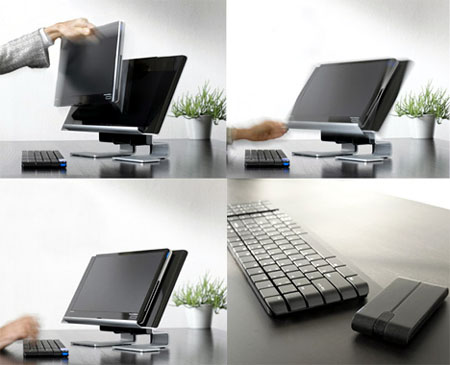The machine on the photo above is my current PC. An AMD FX-6300@4,5GHz with 16GB RAM, Radeon HD 6870, Samsung 128GB 840 SSD, 1TB HDD and a case with 5x 120mm fans… but this desktop computer running Windows 7, built for optimal gaming performance and value, is a dinosaur. The desktop PC era is coming to an end and the big players in the PC world understood it. The Home Personal Computer that had a specific immobile place in your apartment or house is dead. Most people use notebooks, tablets, smart phones or video game consoles for media and content consumption as well as social actives. Microsoft made the bold move with Windows 8 and hardware makers along with chip makers like Intel and AMD try to adapt to the new situation. CPUs tend to become System-On-Chips integrating GPUs even in the x86 world as they would try to copy ARM, the dominant architecture for mobile chips. For home consumers I think the Windows x86 PC will survive as a hybrid tablet and Microsoft did a good job so far in initiating this transition. They killed the desktop user interface along with the task bar and the start button and adapted Windows to work with a touch interface. Not many people know but Microsoft was behind the design of most first generation Windows 8 Tablet hardware along with releasing their own reference device, the Surface RT and Surface Pro (more info: http://news.cnet.com/8301-10805_3-57561849-75/how-microsoft-became-a-control-freak-with-tablet-makers/).
The big question is if corporations will adapt to Windows 8. I talked with the IT support folks in my company and none of them can imagine using Windows 8 in the corporate environment. There is also a funny video about an admin reacting to Windows 8 on YouTube:
Everyone who is into content creation, will it be image or video/audio editing, print layout (aka DTP), web design or programming, won’t give up a mouse and a desktop user interface designed for it. No matter if on a Windows 7 PC, Linux PC, or Mac Pro or even a Notebook/Ultrabook or MacBook Pro/iMac/Mac mini. All of them are designed to be used with a track-pad or mouse. OK, it’s possible to do some nice content creation with touch and there are some cool Apps but I feel they are still toys compared to the mature software packages used on desktop machines. Also the classic office application suite is difficult to use on touch and you need also a wireless printer even though I reckon Microsoft did a good job with Office 2013. For typing a physical keyboard is a must but most Windows 8 tablets are hybrids anyway. It’s understandable why Microsoft want’s to keep this exclusive to Windows 8 and is not releasing an iOS Office version (more: http://www.zdnet.com/why-ballmer-doesnt-want-office-on-the-ipad-7000010566/). So the problem of Windows 8 is the hardware but it’s about innovative corporate hardware!
The following article by a professional analyst comes to the same conclusion more or less: http://www.computerworld.com/s/article/9236658/If_the_PC_dies_Windows_8_will_be_its_killer_says_analyst
So far I didn’t see many corporate hardware concepts for Windows 8 that are compelling enough but the ones that are our there come surprisingly from Dell (yes, the company that went private lately). It seems that most hardware makers like Lenovo with the Yoga 13 forgot to release a docking station. In my option an essential piece of hardware making life easier in a corporate environment is a docking station (or do you want to plug in your keyboard, mouse, wired network and monitor each time?). Windows 8 has multi-monitor support so such a configuration can work pretty well in my option (more: http://blogs.msdn.com/b/b8/archive/2012/05/21/enhancing-windows-8-for-multiple-monitors.aspx).
Another concept that makes sense is a kind of stand for the tablet that connects keyboard and mouse wireless.
Of course you could tilt a touch PC like this Dell and use it in a kind of Star Trek Geordi La Forge manner by typing and touching the interface.
My advice to Microsoft would be to release a set of Windows 8 (or Windows Blue by that time) reference devices similar to the Surface Pro especially optimized for the office corporate environment and content creation. The Surface Pro is a good start but more has to follow and most importantly those devices have to prove they improve efficiency similar to what is shown on the video below.





